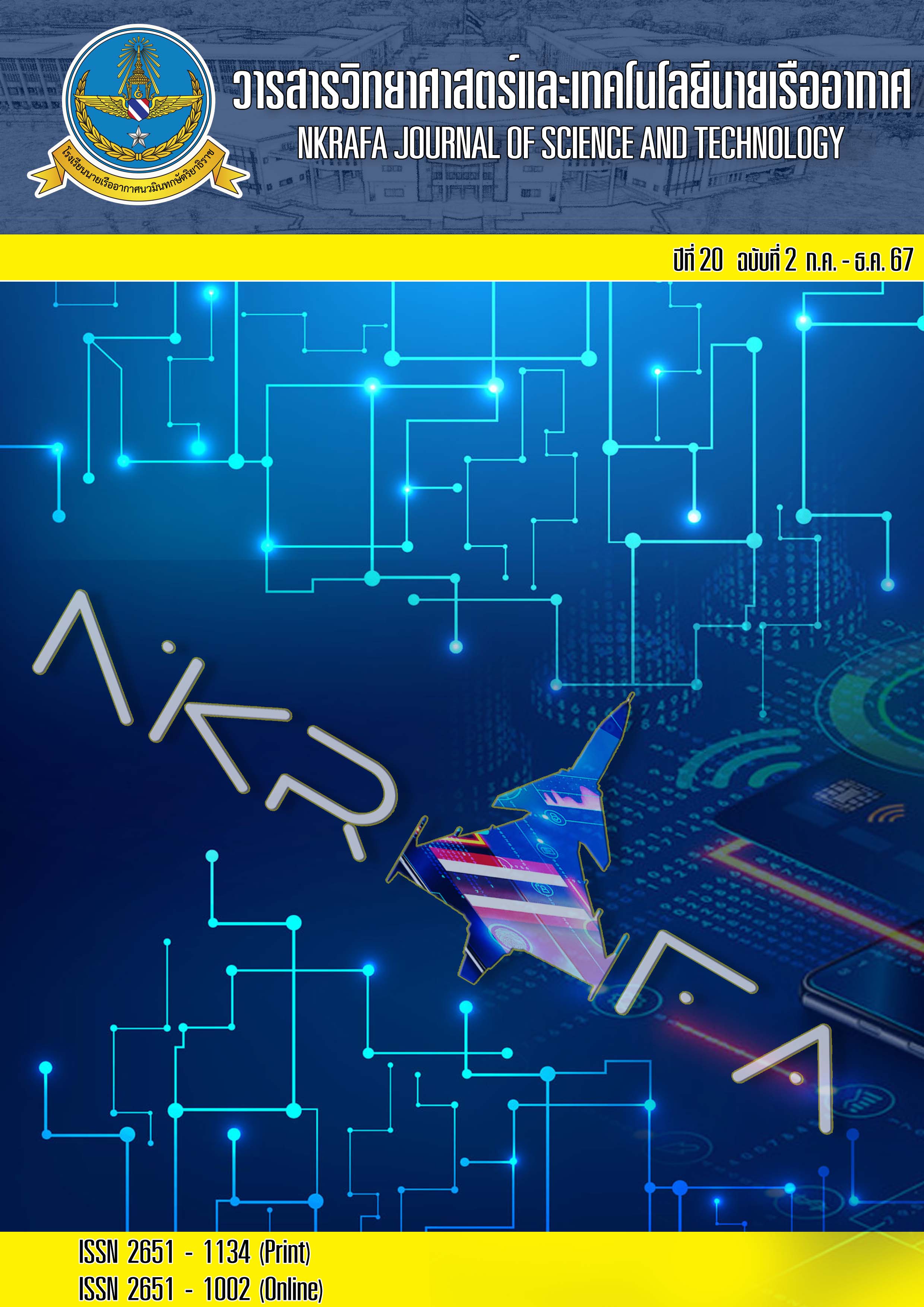การวิเคราะห์และการประเมินแบบจำลองการทำนายอากาศยานบนพื้นฐานข้อมูลของเป้าหมายไม่ทราบฝ่ายอัตโนมัติ
Main Article Content
บทคัดย่อ
แบบจำลองการทำนายอากาศยานถูกพัฒนาขึ้นเพื่อระบุประเภทและแบบของอากาศยานจากข้อมูลเป้าหมายไม่ทราบฝ่ายซึ่งเป็นปัจจัยในการตัดสินใจกลยุทธ์ทางทหารเพื่อให้เกิดความได้เปรียบทางยุทธวิธี อากาศยานที่สำคัญประกอบด้วย อากาศยานขับไล่โจมตี อากาศยานลำเลียง เฮลิคอปเตอร์ และอากาศยานที่ใช้สำหรับการฝึก อากาศยานเหล่านี้ล้วนมีความสามารถสร้างความเสียหายและเป็นภัยต่อความมั่นคงของชาติหากถูกระบุว่าเป็นเป้าหมายไม่ทราบฝ่ายบนจอเรดาร์ของระบบเรดาร์ป้องกันภัยทางอากาศในกองทัพอากาศ อากาศยานแต่ละประเภทมีแบบของอากาศยานที่หลากหลาย ซึ่งแต่ละแบบมีความสามารถในการทำภาระกิจที่แตกต่างกัน เช่น
บินในระยะไกล การบรรทุก ทิ้งระเบิดและโจมตี และสอดแนม ด้วยเหตุนี้การป้องกันภัยทางอากาศจำเป็นที่จะต้องระบุประเภทและแบบของอากาศยานได้อย่างมีประสิทธิภาพเพื่อสามารถตัดสินใจในกลยุทธ์การตอบโต้ที่เหมาะสม แม้ว่าจะมีการศึกษาการสร้างแบบจำลองการทำนายอากาศยานจากงานวิจัยในอดีต พบว่าเป็นเพียงการทำนายเพื่อระบุประเภทหรือทำนายแบบอากาศยานเพียงเท่านั้นซึ่งมีข้อจำกัดในการนำไปใช้งาน ดังนั้นแบบจำลองการทำนายอากาศยานมีความจำเป็นที่จะต้องถูกนำมาพิจารณาจากวิธีการที่เหมาะสมกับความต้องการในการระบุประเภทและแบบอากาศยาน งานวิจัยนี้ดำเนินการวิเคราะห์และประเมินแบบจำลองการทำนายอากาศยานที่ใช้เทคนิคการจำแนกประเภทข้อมูลที่ทันสมัย ได้แก่ Neural Network, Decision Tree, Random Forest, K-Nearest Neighbors, Support Vector Machine, Naïve Bayes, Adaptive Boosting, Gradient Boosting และ Stochastic Gradient Descent การประเมินแบบจำลองดำเนินการผ่านค่าทางสถิติที่เกี่ยวข้องกับการจำแนกข้อมูล เช่น Area under ROC, Classification Accuracy, Precision, Recall และ Matthews Correlation Coefficient ผลการวิจัยพบว่า แบบจำลองที่มีความเหมาะสมและประสิทธิภาพสูงสุดในการนำไปใช้ ได้แก่ แบบจำลองที่พัฒนาจากเทคนิค Neural Network และ Random Forest ตามลำดับ
Article Details

This work is licensed under a Creative Commons Attribution-NonCommercial-NoDerivatives 4.0 International License.
- เนื้อหาและข้อมูลในบทความที่ตีพิมพ์ในวารสารวิทยาศาสตร์และเทคโนโลยีนายเรืออากาศ ถือเป็นข้อคิดเห็นและความรับผิดชอบของผู้เขียนบทความโดยตรง กองบรรณาธิการวารสาร ไม่จำเป็นต้องเห็นด้วย หรือร่วมรับผิดชอบใด ๆ
- บทความ ข้อมูล เนื้อหา รูปภาพ ฯลฯ ที่ได้รับการตีพิมพ์ในวารสารวิทยาศาสตร์และเทคโนโลยีนายเรืออากาศถือเป็นลิขสิทธิ์ของวารสารวิทยาศาสตร์และเทคโนโลยีนายเรืออากาศ หากบุคคลหรือหน่วยงานใดต้องการนำทั้งหมดหรือส่วนหนึ่งส่วนใดไปเผยแพร่ หรือเพื่อกระทำการใด ๆ จะต้องได้รับอนุญาตเป็นลายลักอักษรณ์จากวารสารวิทยาศาสตร์และเทคโนโลยีนายเรืออากาศ ก่อนเท่านั้น
References
Cai, Yu, Dushhyanth Rajaram, and Dimitri N. Mavris. "Multi-mission multi-objective optimization in commercial aircraft conceptual design." AIAA Aviation 2019 Forum. 2019.
กองการบิน. “คู่มือการบินติดตามการเปลี่ยนแปลงทรัพยากรธรรมชาติและสิ่งแวดล้อม.” สำนักงานปลัดกระทรวงทรัพยาการธรรมชาติและสิ่งแวดล้อม. 2562.
Mancini, Andrea, Jacopo Zamboni, and Erwin Moerland. "A knowledge-based methodology for the initiation of military aircraft configurations." AIAA AVIATION 2021 FORUM. 2021.
P. Daungklang and R. Kruakao, “Models for automatic aircraft type prediction”, NKRAFA SCT, vol. 15, pp. 1–8, Dec. 2019.
P. Anchuen and N. Phisutthangkoon, “A Model of Fighter Aircraft Classification Based on Information of Unknown Target Using Artificial Neural Networks”, J Appl Res Sci Tech, vol. 21, no. 2, pp. 89–103, Nov. 2022.
พระราชบัญญัติว่าด้วยการปฏิบัติต่ออากาศยานที่กระทำผิดกฎหมาย พ.ศ. ๒๕๕๓
Mekruksavanich, Sakorn. "ระบบฐานข้อมูลเทคโนโลยีป้องกันประเทศ." Defence Technology Academic Journal 2.5 (2020): 4-15.
Khera, K. K. (2020). Air Defence Command-A Bold Test Case.
W. Petchmak, P. Daungklang and P. Anchuen, "Comparing Coverage Models of Radar: Evaluating Viewshed Against Ground Truth Detection," 2023 8th International STEM Education Conference (iSTEM-Ed), Ayutthaya, Thailand, 2023, pp. 1-4, doi: 10.1109/iSTEM-Ed59413.2023.10305727.
P. Uthansakul, P. Anchuen, M. Uthansakul and A. Ahmad Khan, "Estimating and Synthesizing QoE Based on QoS Measurement for Improving Multimedia Services on Cellular Networks Using ANN Method," in IEEE Transactions on Network and Service Management, vol. 17, no. 1, pp. 389-402, March 2020, doi: 10.1109/TNSM.2019.2946091
Riduwan, H. S. (2007). Pengantar Statistika Untuk Penelitian: Pendidikan. Sosial, Komunikasi Ekonomi, dan Bisnis, Alfabeta, bandung.
Li, Zewen, Fan Liu, Wenjie Yang, Shouheng Peng, and Jun Zhou. "A survey of convolutional neural networks: analysis, applications, and prospects." IEEE transactions on neural networks and learning systems (2021).
Costa, Vinícius G., and Carlos E. Pedreira. "Recent advances in decision trees: An updated survey." Artificial Intelligence Review 56, no. 5 (2023): 4765-4800.
Hu, Jianchang, and Silke Szymczak. "A review on longitudinal data analysis with random forest." Briefings in Bioinformatics 24.2 (2023): bbad002.
Bansal, Malti, Apoorva Goyal, and Apoorva Choudhary. "A comparative analysis of K-nearest neighbor, genetic, support vector machine, decision tree, and long short term memory algorithms in machine learning." Decision Analytics Journal 3 (2022): 100071.
Cervantes, Jair, et al. "A comprehensive survey on support vector machine classification: Applications, challenges and trends." Neurocomputing 408 (2020): 189-215.
Chen, Shenglei, et al. "A novel selective naïve Bayes algorithm." Knowledge-Based Systems 192 (2020): 105361.
Bahad, Pritika, and Preeti Saxena. "Study of adaboost and gradient boosting algorithms for predictive analytics." International Conference on Intelligent Computing and Smart Communication 2019: Proceedings of ICSC 2019. Springer Singapore, 2020.
Velthoen, Jasper, et al. "Gradient boosting for extreme quantile regression." Extremes 26.4 (2023): 639-667.
Liu, Yanli, Yuan Gao, and Wotao Yin. "An improved analysis of stochastic gradient descent with momentum." Advances in Neural Information Processing Systems 33 (2020): 18261-18271.
Demsar J, Curk T, Erjavec A, Gorup C, Hocevar T, Milutinovic M, Mozina M, Polajnar M, Toplak M, Staric A, Stajdohar M, Umek L, Zagar L, Zbontar J, Zitnik M, Zupan B (2013) Orange: Data Mining Toolbox in Python, Journal of Machine Learning Research 14(Aug): 2349−2353. Retrieved Feburary 2024, from https:// https://orangedatamining.com/

